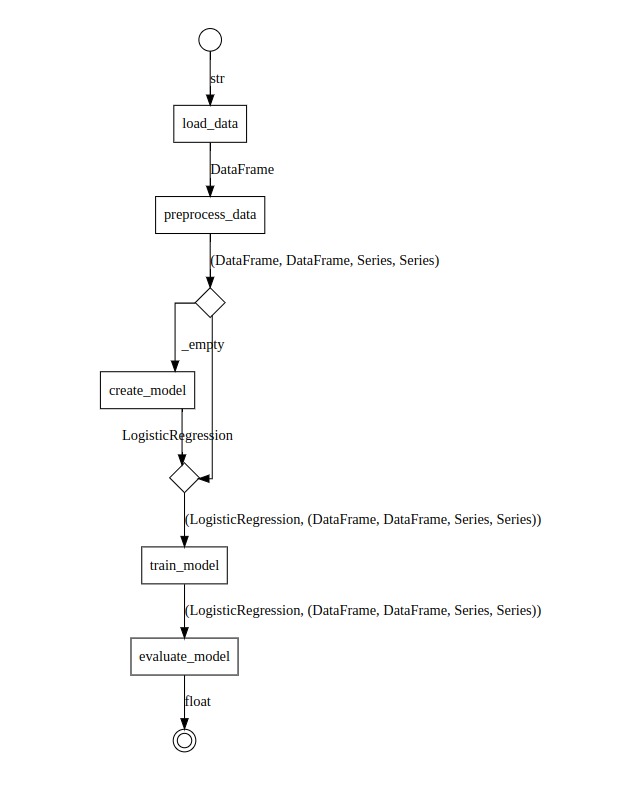Gloe & Scikit-learn¶
Let’s create an example that demonstrates how to use Gloe with Scikit-Learn for a machine learning workflow. We will include steps for data loading, preprocessing, model training, and evaluation. A similar example using PyTorch is available here.
Setup¶
Ensure you have the necessary packages installed:
pip install gloe scikit-learn pandas
The below imports are necessary for the rest of the code:
import pandas as pd
from sklearn.model_selection import train_test_split
from sklearn.preprocessing import StandardScaler
from sklearn.linear_model import LogisticRegression
from sklearn.metrics import accuracy_score
from gloe import transformer, partial_transformer
from gloe.utils import attach
Define the Transformers¶
Let us create transformers for loading data, preprocessing, model creation, training, and evaluation.
Data Load and Preprocessing¶
Loading data from a CSV file into a Pandas DataFrame:
@transformer
def load_data(file_path: str) -> pd.DataFrame:
return pd.read_csv(file_path)
The preprocess_data transformer preprocesses the DataFrame, splits it into training and test sets, and standardizes the features.
@transformer
def preprocess_data(df: pd.DataFrame) -> tuple[pd.DataFrame, pd.DataFrame, pd.Series, pd.Series]:
# Assume the last column is the target
X = df.iloc[:, :-1]
y = df.iloc[:, -1]
# Split data into training and test sets
X_train, X_test, y_train, y_test = train_test_split(X, y, test_size=0.2, random_state=42)
# Standardize features
scaler = StandardScaler()
X_train = scaler.fit_transform(X_train)
X_test = scaler.transform(X_test)
return X_train, X_test, y_train, y_test
Once the type tuple[pd.DataFrame, pd.DataFrame, pd.Series, pd.Series] is used in many places, we can create a type alias for it:
from typing import TypeAlias
Data: TypeAlias = tuple[pd.DataFrame, pd.DataFrame, pd.Series, pd.Series]
Thus, the definition of the preprocess_data transformer can be simplified:
@transformer
def preprocess_data(df: pd.DataFrame) -> Data:
...
Model Training and Evaluation¶
Defining a logistic regression model using Scikit-Learn API:
@transformer
def create_model(_) -> LogisticRegression:
model = LogisticRegression(random_state=42)
return model
Note
Transformers need to have at least one argument. The _ argument is a placeholder that is not used in the transformer.
Training the logistic regression model using the provided data, with the number of iterations specified as a partial argument:
@partial_transformer
def train_model(entry: tuple[LogisticRegression, Data], max_iter: int = 100) -> tuple[LogisticRegression, Data]:
model, data = entry
X_train, _, y_train, _ = data
model.max_iter = max_iter
model.fit(X_train, y_train)
return model, data
Finally, evaluates the trained model on the test data and returns the accuracy score.
@transformer
def evaluate_model(model: LogisticRegression, data: Data) -> float:
X_train, X_test, y_train, y_test = data
y_pred = model.predict(X_test)
accuracy = accuracy_score(y_test, y_pred)
return accuracy
Create the Pipeline¶
The transformers are composed into a pipeline using the >> operator.
load_data, preprocess_data, create_model, train_model, and evaluate_model are chained together. The train_model transformer is provided with the max_iter parameter using the partial transformer method.
pipeline = (
load_data >> preprocess_data >>
attach(create_model) >> train_model(max_iter=200) >> evaluate_model
)
The only point that needs attention is the attach function that is used to attach the input of the create_model transformer to its output.
Let’s analyze the types carefully:
create_modelhas a typeTransformer[Any, LogisticRegression].train_modelhas a typeTransformer[tuple[LogisticRegression, Data], tuple[LogisticRegression, Data].
So, we cannot connect them directly. The attach function receives the create_model transformer and returns a new transformer with the input of create_model attached to its output. The transformer returned by attach has the type Transformer[Data, tuple[LogisticRegression, Data]: exactly what the train_model needs.
Run the Pipeline¶
The pipeline is executed by calling it directly with the input file_path. The final output is the accuracy of the model evaluation.
def main():
file_path = 'data.csv'
accuracy = pipeline(file_path)
print(f"Model evaluation accuracy: {accuracy}")
main()
Plot the Pipeline¶
Finally, we can visualize the pipeline using the .to_image() method:
pipeline.to_image('scikit-learn-pipeline.png')
